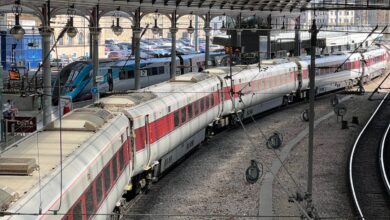How a tragedy at Manchester airport saved hundreds of passengers in the Tokyo plane crash

“As the aircraft stopped, the aft cabin was suddenly filled with thick black smoke which induced panic amongst passengers in that area, with a consequent rapid forward movement down the aisle.
“Many passengers stumbled and collapsed in the aisle, forcing others to go over the seat-backs towards the centre cabin area, which was clear up until the time the right overwing exit was opened.
“A passenger from the front row of seats looked back as he waited to exit the aircraft, and was aware of a mass of people tangled together and struggling in the centre section, apparently incapable of moving forward. He stated ‘people were howling and screaming’.”
That horrifying account of unfolding tragedy is taken from the official report into the last fatal accident involving British Airways.
On 22 August 1985, a Boeing 737 belonging to BA’s charter subsidiary, British Airtours, accelerated along the runway at Manchester airport, destination Corfu. An engine failure started a fire. The pilots aborted the take-off, stopped the plane and ordered an emergency evacuation.
In the ensuing chaos, only 83 of the passengers and crew made it out alive. One initial survivor died six days later, taking the death toll to 55 – most of them killed by a mix of poisonous gases.
“Many survivors from the front six rows of seats described a roll of thick black smoke clinging to the ceiling and moving rapidly forwards along the cabin,” the accident report continues.
“On reaching the forward bulkheads it curled down, began moving aft, lowering and filling the cabin. Some of these passengers became engulfed in the smoke despite their close proximity to the forward exits.
“All described a single breath as burning and painful, immediately causing choking. Some used clothing or hands over their mouths in an attempt to filter the smoke; others attempted to hold their breath. They experienced drowsiness and disorientation, and were forced to feel their way along the seat rows towards the exits, whilst being jostled and pushed.”
Almost 40 years later, on 2 January 2024, a Japan Airlines Airbus A350 was cleared to land on runway 34R at Tokyo’s main airport, Haneda. A small Dash-8 propeller plane belonging to the Japanese coastguard had been told to hold short of the runway but – we now know from the release of air-traffic control messages – strayed onto it.
“It seems to be that the guy in the Dash-8 lined up without permission,” says Rowland Burley – a former Cathay Pacific Boeing 747 pilot who has flown into Haneda many times.
“I understand he’d been taxiing for an hour already, so he was probably impatient to be off – very ‘go minded’. It’s just weird that he didn’t look up and see this large A350 coming in and about to land on top of him.
“It’s just so sad that at night the A350 pilots didn’t actually see this guy in front of them.
“I can understand that because there’s lots of lights around, it’s very bright, you’ve got the city quite close and Yokohama [a large port] and stuff, so there would be a lot of confusion with other lights around.”
The Japan Airlines A350 struck the Dash-8, and both aircraft caught fire. The captain of the coastguard plane escaped, but his five colleagues perished.
Scenes from the Japan airport crash
The passenger jet continued for 1km along the runway, in flames. On board: 367 passengers, including eight infants under two, and 12 crew. The public address system failed, meaning cabin crew had to shout and use megaphones to order the evacuation. Only three of the eight emergency slides could be used because of the fire engulfing much of the aircraft.
The circumstances so far bear a strong resemblance to the British Airtours tragedy at Manchester, but with nearly three times as many people at risk.
Yet all 379 people escaped from the aircraft. In terms of physical injury, there nothing worse than bruises; the emotional toll of being involved in a near-death experience can only be imagined.
The Manchester disaster helped save their lives. Airlines are ferociously competitive – except in the most important aspect of all, safety. The aviation industry is based on open, collaborative investigation. The imperative is not to apportion blame, but to protect future passengers by learning from tragedy.
The Japan Airlines A350 struck the Dash-8, and both aircraft caught fire
Safety measures: Airbus schematic of escape slides on one side of the Airbus A350. Only three could be used for the Tokyo evacuation





